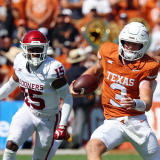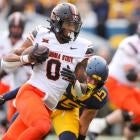The NCAA released Monday new guidelines for concussion safety, including limiting live contact football practices to two per week during the season.
The guidelines address contact at football practices, independent medical care for all athletes, and best practices to diagnose and manage concussions. The NCAA, which faces multiple concussion lawsuits, worked with the College Athletic Trainers’ Society, several medical organizations, multiple conferences and the American Football Coaches Association to create guidelines, not rules.
Dr. Brian Hainline, the NCAA’s chief medical officer, said these guidelines may become NCAA legislation at some point. But because the science about concussions is evolving, Hainline said guidelines through “inter-association consensus” are the best way to create what he hopes will be a cultural change in college sports.
“Whereas some people say what teeth does this have, you can say what teeth does anything have?” Hainline said. “If I’m at a school and know the guidelines are the consensus and 10 of the leading medical organizations say we believe this is the right thing to do and I’m not doing that at my local campus, that has the same sort of teeth if I had 1,100 people working for me who are sitting at the 1,100 schools trying to be a watchdog. And even that wouldn’t work because how could you watch all the sports at once?”
The Ivy League and Pac-12 are the only conferences that currently have live-contact practice rules. The NCAA has not had live hitting rules. The NCAA’s new practice guidelines:
* Preseason: Four live contact practices per week, with a maximum of 12 in the preseason. Only three practices (scrimmages) can allow for live contact to exceed 50 percent of the practice schedule. Live contact is only allowed once a day on days with two practice sessions.
* Inseason, postseason and bowl season: No more than two live contact practices per week.
* Spring practice: Eight of the 15 practices may involve live contact; three of those live contact practices may exceed 50 percent live contact (scrimmages). Live contact practices are limited to two in a given week and may not occur on consecutive days.
The NCAA guidelines define live practice as “any practice that involves live tackling to the ground and/or full-speed blocking. Live contact practice may occur in full-pad or half-pad.” Live contact doesn’t include “thud” sessions in which players hit but stay on their feet, or drills that involve “wrapping up” since “players are not taken to the ground and contact is not aggressive in nature,” according to the guidelines.
The guidelines state there is limited data addressing the issue of live contact vs. teaching and conditioning. But the guidelines cite a presentation by North Carolina head football athletic trainer Scott Trulock that found:
* "The number of non-concussive head impacts sustained in helmets-only and full-pad practices is higher than those sustained in games/scrimmages."
* "Mild- and moderate-intensity head impacts occur at an essentially equal rate during full and half-pad practices when the intent of practice is not noted."
* "Severe-intensity head impacts are much more likely to occur during a game, followed by full-pad practices and half-pad practices."
* "There is a 14-fold increase in concussive impacts in full-pad practices when compared to half-pad or helmets-only practices."
* "Offensive linemen and defensive linemen experience more head impacts during both full-pad and half-pad practices relative to all other positions."
“Could there be pockets of opposition (from coaches)? It wouldn’t surprise me,” said Oklahoma head athletic trainer Scott Anderson, president of the College Athletic Trainers’ Society. “But we’ve vetted these things very strongly through all of the stakeholders and everybody had an opportunity to give their say.”
Independent medical care guidelines
Last September, the Chronicle of Higher Education surveyed the 120 largest college football programs for how they handle concussions. Fifty-three athletic trainers/staff members said they had felt pressure from football coaches to return a player faster than what was medically needed. Thirty-two of the respondents said a member of the football coaching staff had influence over employment decisions for their position.
The new NCAA independent care guidelines state that the team medical director and primary athletics health care providers must have clear and transparent authority when caring for injured players. At a minimum, the NCAA says schools should designate a licensed physician to serve as medical director who oversees the medical tasks to athletes.
The NCAA guidelines state different hiring models can work for college sports medicine. Athletic health care professionals often work for the athletic department, student health services, private medical practices, or a combination.
Hainline initially wanted every medical care provider for athletes to be hired by student health services or a medical school. He said he changed his opinion after visiting more than 50 schools and seeing different models in action.
“I think we’re still on a learning curve on what’s the best way to do this,” Hainline said. “I do think it has to vary by the resources of the university, too. I’ve seen all the models we describe in this paper and in some of the schools it’s extraordinary how well it’s working out.”
To independently treat athletes, the NCAA guidelines list 10 guiding principles from the Inter-Association Consensus Statement on Best Practices for Sports Medicine Management for Secondary Schools and Colleges.
Diagnosing and managing concussion guidelines
The NCAA currently requires schools to provide concussion management plans, but the association doesn’t enforce them. That has been an issue in ongoing NCAA concussion lawsuits.
In November, Rep. Linda Sanchez (D-Calif.) wrote NCAA president Mark Emmert seeking answers about the NCAA’s concussion management policy. She inquired due to the circumstances involving the 2011 death of Frostburg State football player Derek Sheely, who died after suffering a brain injury during preseason practice.
A lawsuit brought by the Sheely family claims Frostburg State coaches kept berating Sheely to continue practicing even though he was bleeding profusely from his forehead after multiple hits to the head over several days. Sheely’s parents expressed surprise the NCAA did not investigate their son’s death.
The NCAA responded that each school is responsible for the welfare of athletes and that risk can’t be completely removed from sports. The NCAA has argued in court it doesn’t have a legal duty to protect athletes.
The NCAA’s new guidelines recommend that schools make their concussion management plans publicly available, either through printed material or on their website. The eight-page guidelines about diagnosing and managing concussions includes best practices the NCAA says have been endorsed by 10 groups in the medical field, such as the American Academy of Neurology, the American College of Sports Medicine and the NCAA Concussion Task Force.
In discovery from a series of lawsuits the NCAA is trying to settle in federal court, an NCAA internal survey from 2010 showed that 50 percent of responding schools didn’t require a concussed player to see a physician. The same survey showed about 50 percent said they would return an athlete to the same game after suffering a concussion.
Hainline said the data he is now working with from all three NCAA divisions doesn’t show those numbers.
'Shameful PR attempt'
Ramogi Huma, who is leading efforts through the College Athletes Players Association for college players to form unions, described the concussion guidelines as “a shameful PR attempt” by the NCAA.
“They didn’t pass rules, they passed guidelines,” Huma said. “They’re unenforceable. If you compare that to some of the rules they do enforce, like a player selling a bowl ring or Johnny Manziel getting paid for signing autographs, there’s a big difference.”
Huma, a former UCLA player, also questions the NCAA guidelines not including "thud" drills in the definition of live hitting. "Thud" drills involve hitting in which a player isn't taken to the ground.
“You can hit a ball carrier as much as you want, but don’t take him to the ground and you make sure nobody falls,” Huma said. “They don’t regulate that. There’s plenty of potential brain trauma for that. As a matter of fact, the only diagnosis of a concussion I had at UCLA was hitting in thud.”
Huma said the NCAA should adopt the NFL/NFLPA standard of contact that’s defined by how players are asked to dress at practice in terms of helmets and pads.
“You don’t leave the decision to a coach who’s not accountable to anybody,” Huma said. “Even if there were rules, it’s all up to the coach on how to interpret those rules. There’s already a blueprint from the NFL on how to do this and the NCAA is ignoring it. We’re not going to let them off the hook.”
The NCAA guidelines said coaches, administrators and athletics health care providers who shaped the best practices "noted that contact during football practice is not determined primarily by the uniform, but rather by whether the intent of practice is centered on live contact versus teaching and conditioning."
Chris Nowinski, executive director of The Sports Legacy Institute, said the NCAA guidelines are a step in the right direction even without rules attached to them.
“I think for what it was intended to do, it addresses a lot of the gaps that existed that left college athletes at risk,” said Nowinski, who directs national concussion research efforts from Boston. “I think it was an impressive effort by a lot of people to put it together quickly with so many organizations involved. Now it needs to be monitored if it’s actually implemented and adopted by individual schools. I think most schools are likely already following the guidelines.”
Hainline described a “perfect storm” existing now due to heightened awareness of concussions. The groundwork for these NCAA guidelines began in January when the College Athletic Trainers’ Society and the NCAA Sport Science Institute hosted a summit about college football safety in Atlanta. The 32 attendees included athletic trainers, neurologists, team physicians and coaches and representatives from the conferences.
Current college athletes were not part of the summit. Professional athletes use unions to negotiate work conditions, such as contact in practices.
"If college football players had a union like NFL players, true concussion reform would already be a reality," Huma said. "Players deserve a real voice when it comes to basic protections."
Hainline said members of the summit working group worked through NCAA student-athlete advisory committees since those athletes are always part of NCAA task forces. Huma said players on those committees made clear in January "they're muzzled" and can't negotiate or produce meaningful change.
Creating enforceable rules, instead of guidelines, could have run the risk of needing one or two years for the NCAA to approve formal legislation with outdated science, Hainline said.
“I’ve never seen a coming together in a six-month period of time like this,” Hainline said. “It was almost like magic was happening. I’m just so thrilled.”















